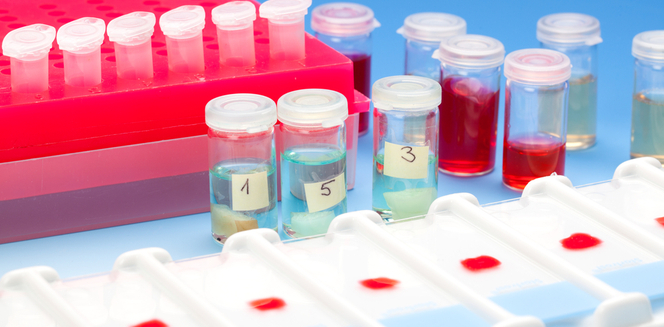Liquid Biopsy for Detecting Early Cancerous Symptoms and Treating Patients

23 Sep
2019
The number of patients suffering from cancer have escalated drastically within last few years. While observing a tumor or lump in a patient, the first step doctors take is to perform tissue biopsy in pinpoint any indications of cancer. Tissue biopsy is a process to collect body cells for microscopic analysis for better understanding of the disease. The microscopic analysis of the cells can determine whether the disease is cancer or not. Moreover, it can illustrate its type and provide further information regarding the patient’s prognosis. Furthermore, it can help to modify the treatment strategy. However, tissue biopsy involves a large needle, an endoscope, and sometimes an open surgery, which could be painful, costly, and a bit risky.
Tissue biopsy has been a difficult process as it was uncomfortable for patients and may include innate clinical risks, potential surgical complications, and economic concerns. Furthermore, some tumors are not easily accessible for tissue biopsy as the patients may have various health conditions. Apart from this, tissue biopsy cannot be recommended to those patients who are going through antiangiogenic treatment. Such issues make it difficult to perform frequent biopsies in intervals on a patient. Since tumors get developed over time, performing this procedure could bring more discomfort. Nevertheless, this process helps to detect and find information regarding the type of and development cancer.
Liquid biopsy to be less painful, cost-efficient, and convenient for cancer patients:
Liquid biopsy revolutionized the way of diagnosing and treating cancer. It is an alternative for tissue biopsy that can analyze tumors with the help of bodily fluids, including blood, urine, and saliva. Liquid biopsy is a non-invasive method of diagnosing and monitoring cancer-related information with the help of biological markers. Previously various liquid biopsy tests included analysis of several kinds of tumor materials including DNA, RNA, proteins, and exosomes.
A liquid biopsy can provide genetic information of all cancer-related lesions and offer opportunities to methodically track enlarging genomes. The tests can detect molecules that favor cancer in patients with the help of samples of bodily fluids such as blood, saliva cerebrospinal fluid, and urine. Moreover, biopsies provide the histological definition of the disease in cancer patients and expose details regarding the genetic outline of the tumor to predict the evolution of the disease in the patient’s body and response to therapies.
Liquid biopsy provides information regarding the further development of cancer in a patient’s body and offers opportunities to improve the survival rate of the cancer patient. It can be used to predict the chances of the disease returning after completing the treatment.
Detecting circulating tumor DNA-based biopsies to detect cancer at an early stage:
Liquid biopsy has been tested to analyze tumor DNA in the blood– ctDNA. The ctDNA-based liquid biopsies are vital to detect cancer at an early stage, as it offers an additional time for the essential treatment to be successful. In some cases, liquid biopsies detected ctDNA in blood samples of patients earlier compared to other conventional method of diagnosis.
Liquid biopsy is useful for frequent tests as it can guide the doctors regarding the development of the tumors. As some tumors are slow-growing and less or not at all harming, operating it might prove to be harmful and risky. Moreover, liquid biopsies provide an advanced understanding regarding evolving metastatic sites, recognizing tumors, and detecting the rate of cancer development in a patient.
One of the major advantages of ctDNA-based liquid biopsy is that they are useful for examining the patient’s responses to the therapy, during and after the treatment. Since it is non-invasive and easily repetitive, it can help clinicians to track the responses to understand what adjustments should be made in the course of treatment.
What’s more, a liquid biopsy provides inclusive imagery of all the cancerous indication in a patient’s body. Unlike tissue biopsy, liquid biopsy informs about the entire body and not just about the cancer-infected area. Liquid biopsy has proved effective for the patients suffering from metastatic gastrointestinal (GI) cancers, as it has presented rare alterations, guiding the doctors to treat accordingly. Liquid biopsy has changed the way of treating cancer over other conventional procedures. Furthermore, it can be used for treating rare type of cancers. Moreover, with further developments and improved therapies, liquid biopsy will garner more attention and would be widely accepted to treat cancer patients.
According to a report published by Allied Market Research, the liquid biopsy market is estimated to reach $3.80 billion by 2023 registering a CAGR of 28.9% during the period 2017–2023. Liquid biopsy has benefitted the healthcare and therapeutic research sectors with its accuracy and molecular aspects. Most importantly, it is non-invasive, cost-effective, and less painful, which has proved to be a miracle treatment for cancer patients. It provides the cancer profile at an early stage and guides the doctors and physicians to follow an appropriate therapy, improving the survival rate of the cancer patients. Liquid biopsy can also be used for rare forms of cancer. Other than that, the surge in the global prevalence of cancer is another contributing factor providing growth to the global liquid biopsy market. However, with scientific advancements, researchers are learning more regarding the potential of liquid biopsy to detect mutations. Thus, the future is expected to be revolutionary for sure.

Rosy Behera
Author's Bio- Rosy Behera holds a bachelor’s degree in Electrical and Electronics Engineering and now she is a content writer by profession. She loves to portray her thoughts and ideas with a nice command of words. Grabbing an audience with her creative write-ups is one of her biggest assets so far. Apart from writing, she is a certified “Odisi” dancer and has done Gardharva in Drawing, Painting, and Arts. She always explores new things through travel and is a big foodie.
Avenue: Entire Library membership of Allied Market Research Reports at your disposal
- Avenue is an innovative subscription-based online report database.
- Avail an online access to the entire library of syndicated reports on more than 2,000 niche industries and company profiles on more than 12,000 firms across 11 domains.
- A cost-effective model tailored for entrepreneurs, investors, and students & researchers at universities.
- Request customizations, suggest new reports, and avail analyst support as per your requirements.
- Get an access to the library of reports at any time from any device and anywhere.
Related Post
-
How are Submarine Cables Transforming Global Connectivity with Enhanced User Experience?
-
Endoscopy Procedures: Transformations in Techniques and Applications
-
AI-Powered Video Analytics: How the Product Actually Works for enterprises
-
Painting Robots: Transforming Precision Coating and Creative Applications
-
Innovations in Pharmacovigilance Systems Advancing Patient Safety
-
Understanding Edge Security: Keeping Data Safe Near the Source
-
Exploring the Use and Advancements of 3D Laser Scanners in Professional Applications
-
Reinforcing Industrial Controls with Smarter Tools and Training








